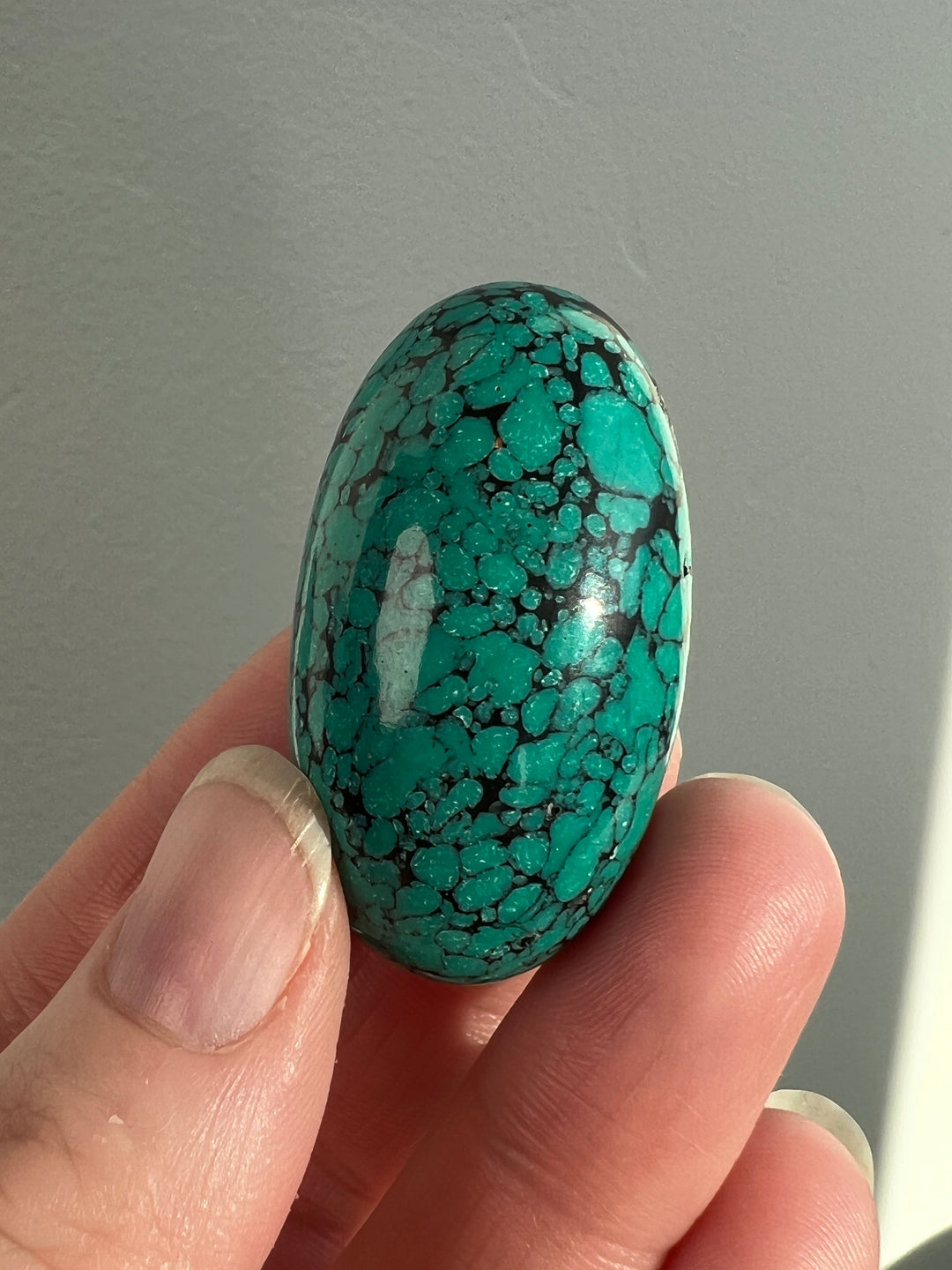Tibetan Turquoise | FAQ
Q: What is Tibetan Turquoise? A: Tibetan Turquoise is a highly valued form of turquoise that originates from Tibet. It is known for its unique coloration, which can range from bright blue to greenish-blue, often with intricate black or brown webbing or matrix patterns. Tibetan Turquoise is prized for its deep spiritual significance and aesthetic beauty in Tibetan culture.
Q: What healing properties are attributed to Tibetan Turquoise? A: Tibetan Turquoise is believed to possess healing and protective properties. It's traditionally seen as a symbol of wealth and prosperity, and is thought to bring peace, good fortune, and protection from negative influences. It is also said to enhance communication, intuition, and spiritual connection.
Q: How can Tibetan Turquoise be incorporated into meditation or spiritual practices? A: In meditation and spiritual practices, Tibetan Turquoise is used as a tool for grounding and connecting with the spiritual world. It's believed to aid in achieving a higher state of consciousness and to promote inner calmness and stability.
Q: What unique characteristics does Tibetan Turquoise possess? A: The most distinctive feature of Tibetan Turquoise is its rich color palette, ranging from sky blue to greenish hues, often intermixed with a natural, intricate matrix. Unlike other types of turquoise, Tibetan Turquoise is typically more greenish and less treated or stabilized, maintaining its natural character.
Q: What is the Mohs hardness of Tibetan Turquoise? A: Tibetan Turquoise typically has a Mohs hardness of around 5 to 6, making it a relatively soft mineral that needs to be handled with care to avoid scratches and damage.
Q: Is Tibetan Turquoise suitable for use in jewelry making? A: Yes, Tibetan Turquoise is commonly used in jewelry, particularly in traditional Tibetan and Nepalese designs. Due to its softness, it is often set in protective bezels and may be treated to enhance its durability.
Q: How should Tibetan Turquoise be cared for and cleaned? A: Tibetan Turquoise should be gently cleaned with a soft, dry cloth. Avoid the use of chemicals, ultrasonic cleaners, and prolonged exposure to water, as they can alter the stone's appearance.
Q: What significance do the color and properties of Tibetan Turquoise hold? A: The colors of Tibetan Turquoise are often associated with the heavens and the sea, symbolizing wisdom, tranquility, and protection. In Tibetan culture, it is considered a sacred stone with profound spiritual significance.
Q: What metaphysical properties are associated with Tibetan Turquoise? A: Metaphysically, Tibetan Turquoise is said to promote spiritual attunement, enhance communication with the spiritual world, and offer protection during travel. It's also believed to bring good luck, peace, and balance.
Q: What are the geological properties of Tibetan Turquoise? A: Geologically, Tibetan Turquoise is a hydrated phosphate of copper and aluminum. It typically forms in arid regions through the process of weathering and the action of acidic solutions on igneous rocks containing copper.
Q: Can you explain the scientific properties of Tibetan Turquoise? A: Scientifically, Tibetan Turquoise is composed of copper, aluminum, and phosphorus elements, with water molecules in its structure. Its blue-green color is due to the presence of copper, while impurities can create its matrix patterns.
Q: What is the mineral composition of Tibetan Turquoise? A: Tibetan Turquoise's chemical formula is CuAl6(PO4)4(OH)8·4H2O, indicating its primary composition of copper, aluminum, and phosphate with water.
Q: Does Tibetan Turquoise fade or change color over time? A: Tibetan Turquoise can change color over time, especially when exposed to sunlight, cosmetics, or oils. It may become more greenish or develop a patina, which some consider enhancing its character.
Q: How can I distinguish between real and fake Tibetan Turquoise? A: Genuine Tibetan Turquoise typically has a unique, uneven coloration with natural matrix patterns. Fakes may use dyes or imitations like plastic or reconstituted turquoise that lack the natural depth and variation of color.
Q: How is Tibetan Turquoise formed? A: Tibetan Turquoise forms in arid regions where copper-rich groundwater seeps through rocks, reacting with phosphorus and aluminum minerals to crystallize as turquoise. This process often occurs near the surface, influenced by weathering conditions.
Q: Are there different types or variations of Tibetan Turquoise? A: Tibetan Turquoise varies in color, ranging from deep blues to greenish hues, and in matrix patterns, which can be dense or sparse. Each piece is unique, contributing to its appeal and value.
Q: What's the historical significance of Tibetan Turquoise? A: Tibetan Turquoise holds a significant place in Tibetan culture and history, used for centuries in traditional jewelry, amulets, and ceremonial objects. It's revered for its spiritual properties and as a symbol of wealth and status.
Q: What is the origin of Tibetan Turquoise? A: The term "Tibetan Turquoise" refers to turquoise sourced from the Himalayan region of Tibet, known for its distinct quality and spiritual importance.
Q: Where is Tibetan Turquoise typically found? A: Tibetan Turquoise is primarily found in the Tibetan plateau and the Himalayan region. Its unique geological environment contributes to its distinctive coloration and properties.
Q: How rare is Tibetan Turquoise? A: High-quality Tibetan Turquoise, especially pieces with intense color and minimal matrix, can be quite rare and sought after. Its rarity is due to limited sources and the unique conditions required for its formation.









